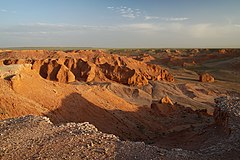| Djadochta Formation | |
|---|---|
| Stratigraphic range: Campanian, ~ | |
 Bayn Dzak (Flaming Cliffs), the type locality of the Djadochta Formation | |
| Type | Geological formation |
| Unit of | Shamo Group |
| Sub-units | Bayn Dzak Member, Tugrugyin Member |
| Underlies | Barun Goyot Formation |
| Overlies | Alagteeg Formation |
| Area | Nemegt Basin, Ulan Nur Basin |
| Thickness | over 90 m (300 ft) |
| Lithology | |
| Primary | Sandstone |
| Other | Mudstone |
| Type section | |
| Named for | Shabarakh Usu (Bayn Dzak) |
| Named by | Berkey & Morris |
| Location | Flaming Cliffs |
| Year defined | 1927 |
| Coordinates | 44°08′19″N 103°43′40″E / 44.13861°N 103.72778°E |
| Approximate paleocoordinates | 30°42′N 9°12′E / 30.7°N 9.2°E |
| Region | Ömnögov |
| Country | Mongolia |
| Thickness at type section | about 90 m (300 ft) |
The Djadochta formation (sometimes transcribed and also known as Djadokhta, Djadokata, or Dzhadokhtskaya) is a highly fossiliferous geological formation in Central Asia, Gobi Desert, dating from the Late Cretaceous period, about 75 million to 71 million years ago. The type locality is the Bayn Dzak locality, famously known as the Flaming Cliffs. Reptile (including dinosaur) and mammal remains are among the fossils recovered from the formation.